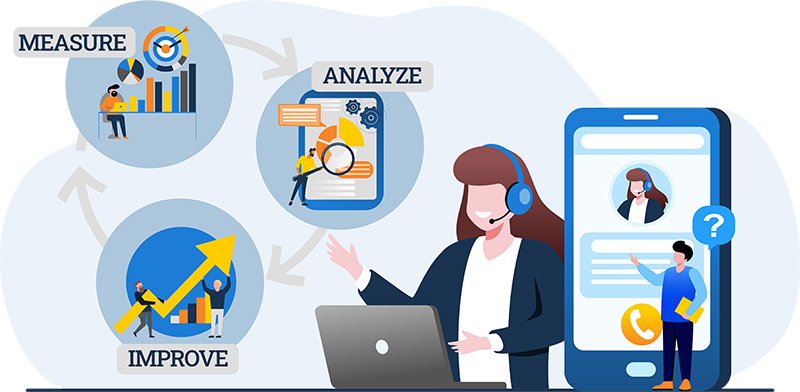How to Measure, Analyze and Improve FCR

First Call Resolution (FCR) is a metric used to measure customer inquiries or problems resolved on the first call with an agent. Ideally, the FCR definition means no repeat calls are required from the initial call from a customer perspective using a call center.
You should continuously measure First Call Resolution (FCR) rate based on external and internal FCR measurement methods. Combining external and internal FCR measurement methods is a powerful approach to measure FCR rate and conduct repeat call analysis so that you can action FCR improvement initiatives.
The only difference between First Call Resolution and First Contact Resolution is the contact channels they measure for FCR (e.g., email, interactive voice response, chat, website, call center, etc.). For example, the First Call Resolution metric name is used when measuring FCR for a call center. The First Contact Resolution metric name is used when measuring FCR utilizing any contact channel.
Industry Average for FCR
SQM’s research shows that the call center industry average for FCR is 70%. For every 1% improvement in FCR, a call center reduces its operating costs by 1%. A 1% improvement in FCR performance equals $286,000 in annual operational savings for the average midsize call center.
SQM’s research shows that 70% of clients who consistently measure their FCR utilizing the post-call customer survey method improve year-over-year. The FCR gain by these call centers ranges from 1-20%. Call centers that implement a post-call survey FCR measurement can expect an average FCR improvement of 3% or better, and in most cases, FCR improvement takes place within 90 days.
External FCR Measurement Method
SQM’s opinion is that the external method for measuring FCR (e.g., post-call surveying, etc.) is the most accurate method for measuring FCR rate. External FCR measurement method lets the customer judge whether FCR took place; after all, their opinion is what matters the most.
Internal FCR Measurement Method
You can use internal methods for measuring FCR (e.g., QA, CRM, telephony technology, etc.) to analyze FCR by focusing on repeat call reasons. Internal FCR data offers an extensive data set for conducting root cause analysis for repeat calls to identify targeted opportunities for improving FCR based on data-driven information.The external FCR measurement method is an outside-in approach, where the customer determines if FCR is achieved. Conversely, the internal measurement method is an inside-out approach, where the organization determines if FCR is achieved. When using internal FCR measurement methods, FCR tends to be 10-20% higher than external FCR measurement methods.
There are many reasons why call center internal FCR measurement is substantially higher than external FCR measurement, some of which are as follows:
- Customers do not call back the organization’s call center
- Complex or certain call types are not included in determining the FCR rate
- Customers calling back the call center using a different phone number
- The organization determines if FCR has been achieved and does not factor in the customer’s opinion if FCR was achieved
- The time frame (e.g., 1-30 days) used to consider the customer’s inquiry resolved is too short
- After the initial call to the call center, a customer used another contact channel to resolve their inquiry; it is considered FCR by the organization, but not the customer
- Use of an FCR rate calculation that inflates the FCR rate
When using external or internal FCR measurement methods, the best practice is to use all customer call data to determine the FCR rate. The benefit of using all customer call data, if possible, is that it is a more accurate approach for determining the FCR rate. When the FCR rate is inflated, the service improvement and cost reduction opportunities are under-reported.
The below figure shows and describes the commonly used external and internal methods for measuring first call resolution rate:
Integrate structured data (e.g., survey ratings, CRM, telephony, etc.) with unstructured data (e.g., customer feedback, call recordings, web chat, etc.) to conduct in-depth dive analysis of repeat calls reasons. Using external and internal methods for measuring FCR allows you to analyze all of the below questions on reducing repeat calls.
You can identify repeat calls by analyzing the following:

- What are the trends from your external and internal FCR measurement methods?
- What call types (e.g., technical, service, sales, etc.) have the highest repeat calls?
- What are your targeted opportunities for reducing repeat call reasons?
- Why were calls unresolved?
- Who was the source of the unresolved calls (i.e., agent, customer, or organization)?
- Why were customers not satisfied with the solution?
- Why do calls need to be transferred?
- Why do calls need to be escalated to another person or manager?
- When a customer used another contact channel such as email, chat, IVR, or website, why did the customer need to use the call center channel?
Once you identify repeat call reasons, you need to analyze the following root causes:

- Are there organizational policies and procedures that hinder FCR?
- Are there customer issues or confusion that hinder FCR?
- Do agent desktop applications or lack of resources hinder FCR?
- Do agents have the skills, knowledge, and abilities to resolve calls?
- Do agents have the necessary coaching to resolve calls?
- Do agents have the motivation and recognition to resolve calls?
- Do your agent call handling (e.g., talk time, wrap up, transfers, hold, etc.) practices hinder FCR?
FCR Criticism
FCR has its critics. There has been a lot of criticism that FCR is complex and difficult to measure. There is no industry standard for internal measurement of FCR, which hinders the benchmarking of FCR against other call centers.
Some leaders feel that FCR is not as crucial of metric as it used to be because so many customers use another contact channel before or after their call center experience. Therefore FCR is not meaningful insight because it does not factor in a customer using multiple channels.
Another criticism of FCR is that it's only useful as a call center metric. Senior management does not view FCR as an enterprise-wide Customer Experience (CX) metric.
No repeat call in a given timeframe is an internal FCR measurement method that uses an organization's criteria for determining its FCR rate. This approach can overstate the FCR rate by 10 to 20% higher than the external FCR measurement (e.g., post-call survey) FCR rate. An inflated FCR rate can discourage leaders from wanting to improve FCR.
FCR Action Plan
The VoC closed-loop improvement process is a well-accepted business practice for developing an FCR action plan. After you have measured your FCR performance, identified and determined the root causes of repeat call reasons, you will need to develop a plan of action (e.g., who, what, why, when, and how) to improve FCR. To ensure that FCR continuously improves, a call center should use an FCR - Identify, Develop, Check, and Act (IDCA) Improvement Cycle to measure and improve FCR performance. The four steps of the FCR-IDCA Improvement Cycle consist of:
Identify - Measure FCR performance and analyze repeat call reasons
Develop - Develop a solution and implement a test pilot to reduce repeat call reseasons
Check - Check to see if the test pilot was successful by measuring FCR
Act - Implement a standardized improvement plan for reducing repeat call reasons

Quick Related Links
First Call Resolution Definition First Call Resolution PPT First Call Resolution Benefits
First Call Resolution Strategies First Call Resolution Operating Philosophy Helpdesk First Call Resolution First Call Resolution Formula Calculate First Call Resolution Rate What Is a Good FCR Rate? Resolution Improvement Tips Agent CX Success Stories FCR Measurement Case Study

